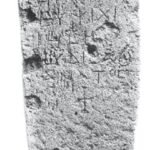| Artefact ID | 1290 |
| TM ID | TM 97447 |
| Findspot (DEChriM ID) | 68 (al-Filusiyya) | Class | Funerary element, Textual |
| Material | Stone |
| Writing medium | Inscription |
| Text content | Subliterary |
| Language | Greek |
| Description | SEG LIX 1881: Epitaph of Joseph. Dahari & Di Segni 2009, no. 9: Anthropomorphic stela of beach-rock of tapering rectangular shape surmounted by a trapezoid head; the bottom is missing. H. 111 cm; W. 40 cm; Th. 13 cm. The head is meticulously fashioned and the outline of the face is depicted with a double line. The inscription is finely incised, mostly with square letters; no traces of paint on the stone. Crosses with emphasized apices mark the beginning and end of the first line and the end of the inscription. The ed. note that the last cross, underneath the epitaph, has a small base, reminiscent of the Calvary crosses common in the Gaza region. Same consolatory formula as in the other steles sharing the same provenance – a combination restricted to the northern coast of Sinai (el-Huweinat and el-‘Arish) according to ed.pr.: εὐμοίρει, εὐψύχει, οὐδεὶς ἀθάνατος, “fare thee well, be of good courage, nobody is immortal”, accompanied by the name of the deceased in vocative. |
| Selection criteria | Christian terms/formulas/concepts, Christian symbols/gestures/isopsephy |
| Date from | 350 |
| Date to | 499 |
| Dating criteria | Phrasing and palaeography point to 4th-5th c. according to ed. pr. |
| Absolute/relative date | Relative date |
| Archaeological context | SEG LIX-1873-1882: One of the ten anthropomorphic stelai acquired in the antiquities market in the 1970s by the Israel Museum in Jerusalem and the Israel Antiquities Authority; returned to Egypt in 1993; all stelai come from the Byzantine nekropolis at el-Huweinat 2 km south of Ostrakine (east of Lake Sirbonitis = Sbakhat el-Bardawil; northern Sinai). |
| Accession number | Formerly: Jerusalem, Israel Museum, Shrine of the book 82.2.961; Tel Aviv, Private collection Dayan number unknown. Returned to Egypt in 1993 (present location unknown) |


 Json data
Json data




